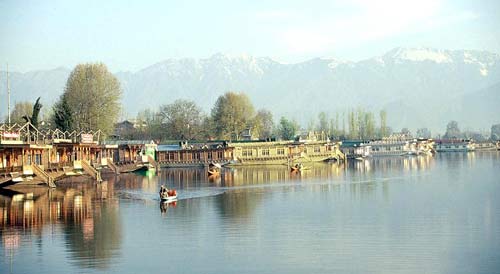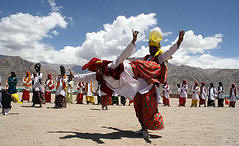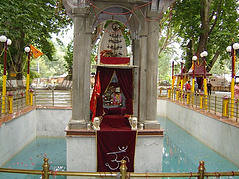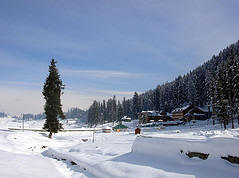Jammu and Kashmir consists of three divisions: Jammu, the Kashmir Valley and Ladakh. Srinagar is the state's summer capital, and Jammu its winter capital. While the Kashmir Valley is famous for its beautiful mountainous landscape, Jammu attracts tens of thousands of Hindu and Muslim pilgrims every year. Ladakh, also known as "Little Tibet", is renowned for its remote mountain beauty and Buddhist culture. Though Islam is practiced by about 65% of population (and 95% of the population in the Kashmir Valley), the state has significant minorities of Hindus (who constitute 67% of the population in Jammu and 30% of the state's population), Buddhists (who constitute 51% of the population in Ladhakh and 3% of the total population of the state), and Sikhs (who form 5% of Jammu's population and 2% of the state's population).

Jammu is beautiful city blessed by nature & situated at the footsteps of the mountains of the Himalayas. A beautiful & enchanting river called Tawi flows through the city. Jammu is also known as the City of Temples, coz it has so many small and big temples & shrine. It is one of the three regions comprising the Jammu and Kashmir. It consists of six districts of the state, namely Jammu (the largest city), Kathua, Poonch, Rajouri, Udhampur and Doda. More than 60% of population is Hindu. The city is ideal for nature lovers, adventure lovers and Pilgrimages. The main highlight is the Mata Veshno Devi temple, located just 61kms from Jammu.
Set like a jewelled crown on the map of India, Kashmir is amulti-faceted diamond, changing its hues with the seasons - always extravagantly beautiful. Two major Himalayan ranges, the Great Himalayan Range and the Pir Panjal, surround the landscape from the north and south respectively. They are the source of great rivers, which flow down into the valleys, forested with orchards and decorated by lily-laden lakes.

The Mughals aptly called Kashmir ‘Paradise on Earth’ where they journeyed across the hot plains of India, to the valley’s cool environs in summer. Here they laid, with great love and care, Srinagar’s many formal, waterfront gardens, now collectively known as the Mughal Gardens. Anecdotes of four and five centuries ago describe their love for these gardens, and the rivalries that centred around their ownership. They also patronized the development of art & craft among the people of Kashmir, leaving behind a heritage of exquisite artisanship among these people and making the handicrafts of the land prized gifts all over the world.
Leh is a beautiful barren desert situated at 3,505 meters above sea level in lap of the Great Himalayas. Leh is the main tourist gateway, its the largest town in the Ladakh region. It is ideal destination for nature lovers and adventure freaks. The main highlights includes the breathtaking landscaping, the enchanting rives, snowcapped mountains complimenting the blue sky, time stopping silence of the desert, temperature below zero and Ladakh festival, in short nature's untouched beauty and incredibly attractive. Leh has so many monuments, monasteries, great options for trekking and mountaineering, river rafting, horse riding and polo.
Fairs and festivals of Jammu and Kashmir are a reflection of the diverse cultural and social heritage of the valley. Like all other parts of India, Kashmir too abounds with numerous fairs and festivals throughout the year. Fairs and festivals of Kashmir are celebrated with much fanfare and joy, regardless of the religion. Lohri is celebrated with as much enthusiasm as Id or Diwali. Given below is a list of the major fairs and festivals of Kashmir:

Lohri
The festival of Lohri is also celebrated as Makar Sakranti. It is celebrated on 13th January to welcome the onset of spring.
Baisakhi
Celebrated on 13th April, Baisakhi is the harvest festival of north India. It is also the day when Guru Gobind Singh founded the Khalsa sect.
Jhiri Mela
This fair is held to commemorate a poor farmer. It is believed that he committed suicide as protest against his tyrant landlord.

Hemis festival
This religious fair is held in the Hemis Gompa in Ladakh. Being celebrated for 12 years, the event is marked by masked dances and other similar festivities.
Purmandal Mela
This three-day fair is organized to commemorate the marriage of Lord Shiva and Goddess Parvati on Shivratri.

Bahu Mela
Bahu Mela is organized twice a year at the Kali temple in Bahu Fort of Jammu.
Mansar Food and Craft
Mela Mansar Food and Craft Mela is a three-day fair organized during Baisakhi season on the banks of the Mansar Lake.
Chaitre Chaudash
Chaitre Chaudash is held in the month of March-April at the village Uttar Behni.

Navratri
At the time of Navratri, a special mela (fair) is held at the Kheer Bhawani temple in the Tullamula village.
Eid-ul-Zoha
Eid-ul-Zoha is celebrated in the month of in July. It commemorates Prophet Abraham, who agreed to sacrifice his son to God.
Eid-ul-Fitr
Eid-ul-Fitr is celebrated in the month of October/November. It marks the end of the fasting month of Ramadan. On this occasion, sweets are prepared and Muslims buy new clothes and pamper themselves with delicious feasts.
Kashmir is famous not only for its scenic beauty but also for its traditional dances. Kashmiri people celebrate their festivities with a number of Kashmiri folk dances. The folk dances and music of the Kashmir valley form an important part of the Kashmiri culture. Given below is a list of some of the famous Kashmir dances:

Rouf
One of the most popular traditional dances of Kashmir is Rouf. This beautiful dance form graces all the festive occasions, especially Id and Ramzan days. The dance is performed by a group of women facing each other. The simple footwork of Rouf is both a visual as well as an artistic treat.
Bhand Pather
Bhand Pather is a traditional folk theatre of Kashmir, usually performed in social and cultural functions. A powerful combination of play and dance, it portrays social traditions and evils, bringing out the satire in them.
Hafiza Dance
Hafiza Dance is a type of Kashmir dance, performed at wedding ceremonies.
Bhand Jashan
Bhand Jashan is another one of the Kashmiri folk dances. It is performed by a group of 10 to 15 artists in their traditional style, along with some light music.
Bacha Nagma
Young boys of Kashmir perform Bacha Nagma dance, particularly during the harvest season. One of the young boys dresses up as a female dancer, performing Hafiza style of dance.
Wuegi-Nachun
A less popular dance of Kashmir is Wuegi-nachun. It is performed after the marriage ceremony, when the bride has left for her new home. In this dance, Kashmiri pundit women dance around the bridal rangoli (pattern made with colors).
Music adds to the attraction of the Kashmir valley for the tourists. The history and tradition of music and dance in Kashmir valley goes back to thousands years back. Given below are some main forms of the traditional music of Kashmir, along with some Kashmiri folk songs:

Chakri
Once performed with the help of only Garaha, Sarangi and Rabab, Chakri has included harmonium also in its presentation. It is one of the most popular forms of the traditional music of Kashmir.
Sufiana Music
Sofians musiqui (Sufi Music) owes its introduction in Kashmir to Iran. Introduced in the 15th century in the Kashmir valley, Sufiana music continues to enthrall its audience till date. With the passage of time, a number of Indian ragas were added to this music form. This classical music form of Kashmir makes the use of Santoor, Sitar, Kashmiri Saz, Wasool or Tabla.
Hafiz Nagma
A part of the classical Sufiana Music, Hafiz Nagma makes use of Santoor-a hundred stringed instrument played with sticks. In Hafiz Nagma, there is a female dancer, accompanied by a number of males with instruments. The dancer, known as Hafiza, moves her feet to the musical notes.
Song of Habba Khatoon
Habba Khatoon was a princess of Kashmir. This song reflects her feelings at the time when she was separated from the Yousuf King.
Surma
Surma is a song in Dogri that reflects the agony of a newly married girl whose husband is away in the Army.

Gulmarg Tourism: Gulmarg is surrounded by dense forests of tall conifers ,Gulmarg is known for unparalled beauty nad is rated as one of the matchless tourist spots of the world. It is famous for Golf hikes and boasts of a beautiful highland golf course.
Jammu Tourism: The City of Jammu is popularly known as the "City of Temeples". Innumerable temples and shrines with glittering "Shikhars" soar into the sky, like caretakers of the city, creating the ambience of a truly holy city.
Kargil Tourism: Kargil district carved out of erstwhile district Ladakh came into existence in July 1979.It lies in the North-east Of Kashmir Valley at a distance of 205 Kms. from Srinagar with a geographical area of 14,036 Sq.Kms.
Leh Tourism: The palace is distinguished monument and a historical building. The nine-storeyed palace was built by the 17th century illustrious ruler of Ladakh, Sengge Namgyal. It is an imposing structure, though in ruins now, situated on a hill and commands a grand view of the Leh town.

Ladakh Tourism: Ladakh, a part of Jammu & Kashmir State in north of India consisting of two districts Leh and Kargil. Leh with an area of 45110 Sq Km makes it largest district in the country in terms of area.
Pahalgam Tourism: Pahalgam has a golf course at 2400 meters above the sea level. Camping equipment, ponies and skiing equipment is readily available. Kolahoi is a popular destinantion via Aru a charming meadow. Pahalgam is base camp for the pilgrims of Amarnath.
Patnitop Tourism: Patnitop is enveloped by thickly wooded forests,Patnitop offers beautiful picnic spots, peaceful walks and breathtaking views of the mountainscape of the Chenab basin. In winter, the resort is generally covered with athick mantle of snow thus providing opportunities for various snow games includingskiing.
Sonamarg Tourism: Sonamarg is a place of enthralling beauty. Three lakes viz Kishensar,Vishensar and Gangabal can be viewed from Nichnai Pass. 20 Kms east of Sonamarg is Zoji-La Pass at 3540 mtrs which leads into Ladakh Plateau.

Srinagar Tourism: Srinagar district is situated in the centre of Kashmir Valley, is surrounded by five districts.In the north it is flanked by Kargil,in the South by Pulwama,in the north-west by Budgam.
Vaishno Devi Tourism: Sri Mata Vaishno Devi Shrine is one of the most popular Shrines of India. The Goddess Vaishno Devi's abode is in 100 feet long cave with a narrow opening. The holy cold and crystal clear water washes the lotus feet of the Mata's "Pindian".
Zangla Tourism: Zangla the old castle now in ruins except from a small chappel, occupies a hill, overlooking the desertic valley below. Nearby is the old Nunnery worth a visit for the austere life style of the small monastic community of nuns.
Zanskar Tourism: Zanskar road winds down the steep slopes of the watershed to the head of the Stod Valley, one of Zanskar's main tributary valleys, the majestic "Drang-Drung" glacier looms into full view.

The "Paradise on Earth" is known, not only for its natural beauty but a number of other things also. One of them is adventure tourism. Infact, adventure tourism in Kashmir is one of the major draws for the tourists. An array of options exists in the valley for the adventure loving visitors. Some of the places in the valley where the adventure sports facilities are available are Gulmarg, Sonmarg, Pahalgam, Drass, etc. The mountain ranges as well as the gushing rivers of the valley provide abundant opportunities for adventure tourism in Kashmir. Some of the main adventure sports in Kashmir valley of India are :
Golf, Mountaineering, Skiing, Trekking, River Rafting, Paragliding in Kashmir, Aero Sports, Backpacking, Canoe Trips, Camping, Kayaking
Get Best Deals Directly in Your Inbox Today !
You will get notification for every deal as it appears
